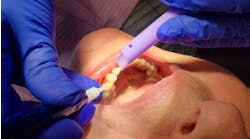Myth busters for dental assistants: Chart notes aren't that important
I hate writing chart notes, and I don’t see the point. They’re no big deal, and it’s stupid to write a novel every time a patient comes in. Right?
WRONG!
Dentists and hygienists are taught how to write chart notes. However, many times it’s the assistants who are asked to write the notes, and we often aren’t taught how to do this job correctly. So, let’s talk about the importance of these notes.
Chart notes can and will be called into evidence in a court of law if the practice is involved in a malpractice suit. The notes are legal documentation and therefore should be treated as such. Not only that, but records are often transferred to other offices when patients change dentists, and you don’t want your notes to sound like they were written by a kindergartener.
Many of us now use “auto notes,” a wonderful feature in our practice management software that allows us to “cheat” and create great notes at the click of the mouse. However, if you don’t have the auto note feature set up correctly, then you won’t get good content. Garbage in means garbage out!
I often notice that people construct their chart notes using slang or their own office lingo. It’s time to stop doing this! Even if it’s only you who goes back and reads the notes, they need to inform you and give you the vision of what happened that day and why. The notes should not be confusing, with incomplete sentences or misspelled words that leave you wondering if you were drinking that day.
Remember to include these steps when making notes in your charts:
1. Patient’s medical history reviewed, signed, and dated.
2. Patient consent forms signed and dated.
3. Pre- and post-operative vitals taken.
4. Routine information such as procedure done, and all information given to the patient for pre- or post-op instructions.
5. SOAP notes. Many dental and medical insurance companies request documentation in the form of SOAP notes. When done correctly, these explain the procedure and the circumstances surrounding it. SOAP stands for
- Subjective—What is the patient’s chief complaint? What are the patient’s symptoms? What are the patient’s health issues that may affect the outcome of treatment, as documented on the health history?
- Objective—What do the doctor and clinical team see when examining the patient regarding vitals, mental state, history of illness and health issues, smoking, pregnancy, etc.? What is the evidence of symptoms affecting the teeth, tissue, and bone, such as periodontal disease, endodontic infection, fracture, decay, missing teeth, broken restorations, or prosthetics?
- Assessment—From the information gathered in the subjective and objective discovery, what does the doctor feel is necessary to return the patient to health? Write this down and prioritize the needs.
- Plan—Establish a written treatment plan for the patient, including number of appointments, codes and procedures, phases of treatments, and any referrals to other providers or specialists.
6. For those patients who use nitrous oxide: Levels of nitrous oxide documented in percentages used and each gas administered, with total volumes. Length of administration. Time patient was oxygenated, and whether the patient feels “normal” prior to dismissal.
7. What anesthetics were used, pre-medication and post-medication.
8. Procedure completed with details.
9. Post-op instructions.
10. Any conversations about the procedure, payment, and billing.
11. Lab used and shade taken.
12. Referrals to specialist.
13. Any follow-up after patient was dismissed.
14. Whether or not any complications occurred. (And yes, this is even in the case of a denture adjustment or a limited exam.)
Are you missing any of these as part of your complete chart records? Then consider adding them to your documentation. Chart notes are far more important than many of us give them credit for. Recognize them for what they are; valuable pieces of information that connect the dots long after the day is done.
Would you be able to go back and read your notes and know exactly what happened that day? Would someone else be able to read your notes and know exactly what happened? You are the link between the events of that day and the pieces of information you gathered. It’s very important for you to remember that!
To read more informative Myth Busters, visit DentistryIQ and search "myth busters for dental assistants."







